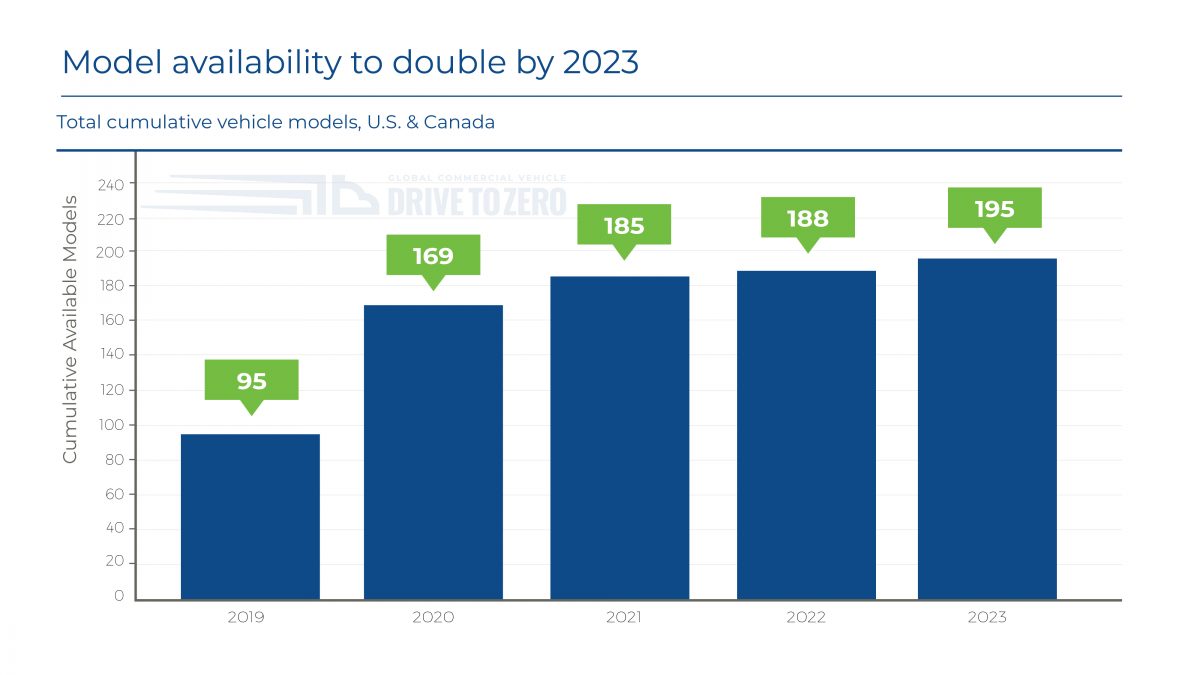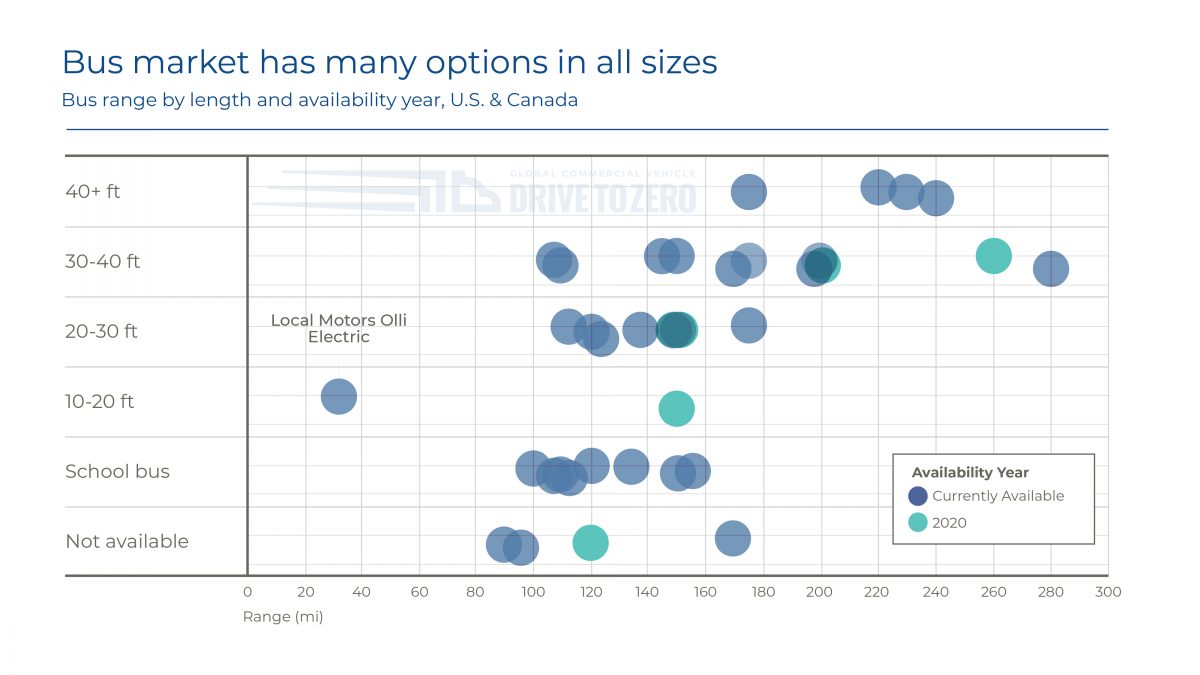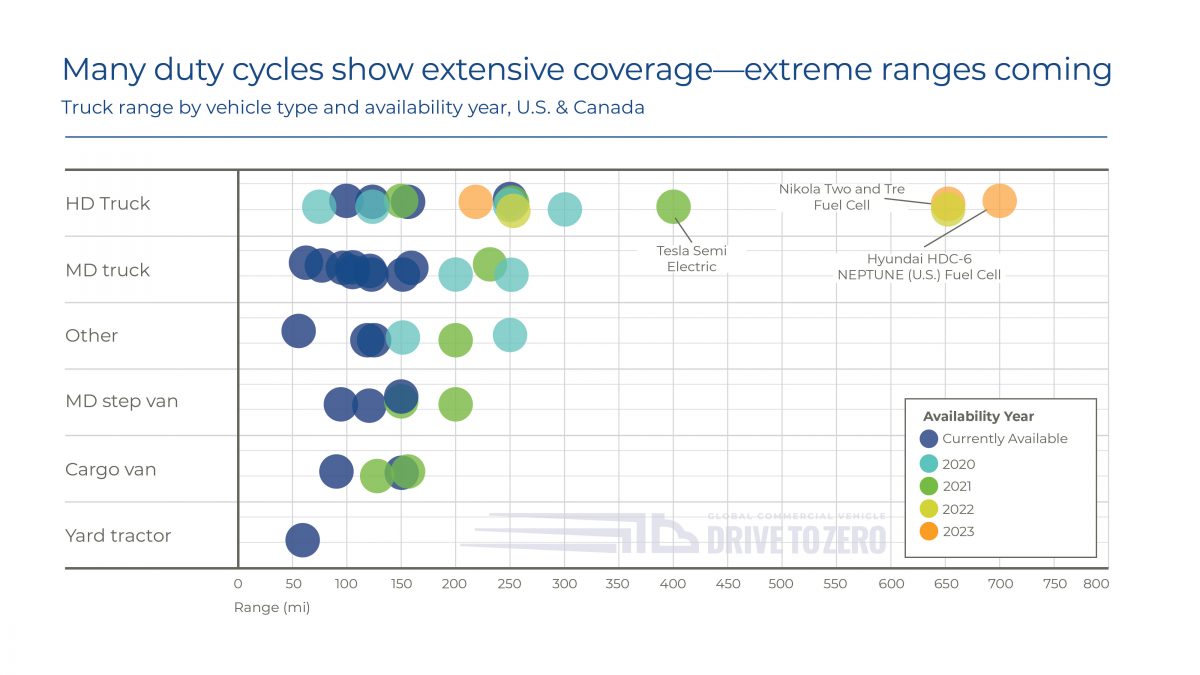Despite the impacts of COVID-19 on vehicle sales and production, zero-emission (ZE) truck and bus models are on the verge of a major surge in the United States and Canada. New data from CALSTART’s Global Commercial Vehicle Drive to Zero’s Zero-Emission Technology Inventory (ZETI) tool shows that by the end of 2020, the United States and Canada are on track to have 169 different ZE commercial vehicle models available or soon-to-be-available for purchase compared to 95 models in 2019 – a 78 percent increase. From 2019 to 2023, model availability is expected to more than double to 195 – a transformative ascent for the clean commercial vehicle segment. Similar trends can also be seen in other leading markets such as China and Europe.

CALSTART’s Global Commercial Drive to Zero’ program’s Zero-Emission Technology Inventory tracks the growth of the zero-emission commercial vehicle segment globally.
Amongst the fastest growing vehicle segments in the US and Canada are medium-duty trucks typically used for urban delivery. After transit buses, they represent the vehicles most poised for zero-emission technologies due to their urban duty cycles composed of stops and goes, known routes, and ability to charge overnight at depots. This trend bodes well for the urban e-commerce sector, now experiencing strong growth due to COVID-19. And because the zero-emission technologies used in transit buses and urban delivery trucks can be transferred to larger trucks, investments in these early markets will lay the technology foundation for use in heavier long-distance trucks.
The new ZETI data also shows that ZE commercial models across nearly all vehicle types currently demonstrate driving range capabilities commensurate with user needs. Most ZE buses can drive between 100 and 200 miles on a single charge. There is already a healthy number of ZE trucks in the 50 to 150 mile range, which is typically sufficient for urban deliveries, and longer ranges over 300 miles are coming in the next two to three years.

 Driving this North American model proliferation is a mixture of market demand, plicy drivers and an increasingly attractive business case. On the demand side, corporate giants like Amazon, IKEA, FedEx, and UPS have made significant commitments and investments in manufacturers of ZE commercial vehicles such as Rivian, Arrival and Chanje in recent months. Australian vehicle technology company SEA Electric – responsible for a healthy uptick in ZE medium-duty-vehicles in North America – recently opened a new facility in Torrance, California after winning a number of West Coast EV truck orders in 2019.
Driving this North American model proliferation is a mixture of market demand, plicy drivers and an increasingly attractive business case. On the demand side, corporate giants like Amazon, IKEA, FedEx, and UPS have made significant commitments and investments in manufacturers of ZE commercial vehicles such as Rivian, Arrival and Chanje in recent months. Australian vehicle technology company SEA Electric – responsible for a healthy uptick in ZE medium-duty-vehicles in North America – recently opened a new facility in Torrance, California after winning a number of West Coast EV truck orders in 2019.
On the policy front, California continues to forge its path as a first-mover for clean transportation technology-driving policies. Already home to the Innovative Clean Transit regulation and California HVIP (a program that provides tens of millions of dollars in discounts to purchasers of clean trucks and buses), the state may soon require that an increasing proportion of sales of new commercial trucks in the state be zero-emissions. New York recently relaunched its NY Truck Voucher Incentive Program, which, like the California program, offers purchasers of clean trucks and buses tens to hundreds of thousands of dollars in discounts on new clean vehicle purchases. Canada recently committed to the purchase of 5,000 ZE buses, offering financial provisions to leading transit agencies to incentivize vehicle purchases and charging infrastructure adoption.
And to the business case, battery pack prices fell 87 percent from $1,100/kWh in 2010 to $156/kWh in 2019, according to Bloomberg New Energy Finance. By 2023, BNEF projects prices will fall even lower to $100/kWh. These falling prices are particularly attractive for commercial vehicle customers, who operate their fleets over long distances and can thus quickly offset higher vehicle capital costs from operational savings.
Covid-19 has brought into sharp focus how critical our shipping and transportation industries and the vehicles that power them are to our worldwide economy and our daily lives. It has also given us a glimpse of the clean air and climate benefits we would reap if zero-emission trucks and buses proliferate in key regions worldwide. Now, more than ever, we see that sustainable economic growth, well-paying jobs in a growing sector, and a clean air future are within grasp as the advanced technology ZE buses and trucks we need to power our daily lives are increasingly available.
Cristiano Façanha, Ph.D., is the Global Director of CALSTART’s Global Commercial Vehicle Drive to Zero program. Dr. Façanha is a noted clean bus and truck and policy expert, coalition builder, and a civil and environmental engineer.
